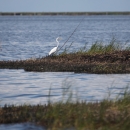States
MichiganBackground
Location: Rouge River, south of Detroit, Michigan. The Rouge River is a tributary of the Detroit River, which flows from Lake Saint Clair southward to Lake Erie.
Date of Incident: 9 April 2002 and 12 April 2002
Incident Description: Following a heavy rain event, a mixture of diesel fuel and lube waste oil was observed the morning of April 9, 2002, in the Rouge River. In the late evening of April 12, 2002, or the early morning of April 13th, another oil spill occurred after a heavy rainfall. It appeared the oil came from one of the combined sewer outfalls on the River Rouge (Baby Creek Outfall). This release was trapped in the River Rouge due to booming at the mouth, preventing further releases oil into the Detroit River. This spill was significantly greater than the first release.
Resources Impacted: Oil released during the first spill impacted approximately 17 miles of shoreline in the United States and almost 10 miles on the Canadian side of the Detroit River, including approximately 1 mile of shoreline at the Lake Erie Metropark where oiled marsh vegetation was cut and removed.
Over the course of the spill, oiled birds and reptiles were observed, including ruddy ducks, buffleheads, mergansers, scaup, coots, mallards, Canada geese, and one dead and two rehabilitated turtles.
Natural Resource Damage Assessment
While no liable party was found to be responsible for this spill, the Trustees conducted a Natural Resource Damage Assessment, completed a Final Damage Assessment and Restoration Plan, and submitted a claim for restoration to the U.S. Coast Guard's National Pollution Fund Center (NPFC). The NPFC denied the claim, so the Trustees have not been able to move forward with restoration to compensate for the impacts of this spill.
The U.S. Fish and Wildlife Service is in the process of updating webpages, so some content that was previously available is temporarily unavailable.



